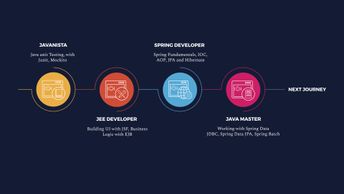Aspire Javanista to Java Master Javanista to Java Master Track 2: Java EE
Final Exam: Java EE will test your knowledge and application of the topics presented throughout the Java EE track of the Aspire Javanista to Java Master Journey.
| Objectives |
Final Exam: Java EE - apply degrees of concurrent access to the methods in a singleton bean
- configure a datasource in Wildfly that links up with a relational database
- configure a Facelet to display the results of a SELECT query execution on a database
- configure page navigation using buttons in a JSF Facelet
- configure user-defined and JSF built-in validators to check user input in a form
- create a client application that invokes a task configured with the enterprise bean timer service
- create and configure a messaging queue on a Wildfly application server instance
- create an entity class in an application that maps to a table in a relational database
- create a table in a relational database and populate it with data
- define navigations rules for a JSF web application in a configuration file
- define the dependencies and configurations for a simple JSF application
- deploy and test a JSF app that enables insert operations on a database
- develop a client application to locate and connect to a remote session bean and use it to invoke methods
- develop a method and configure the UI of your JSF app to allow existing data to be removed from a database
- develop an application that connects to a message queue and places text messages on that queue
- develop and set up methods that are triggered once a user changes a value in an input element
- develop the backing bean and a Facelet with the UI components for a JSF app
- distinguish between stateless and stateful session beans
- download and install the Wildfly (formerly Jboss) application server
- download and set up an Apache TomEE web server where a JSF app can be deployed
- give a theoretical and conceptual overview of Jakarta Server Faces
- identify characteristics or components of the backing bean
- implement a basic stateless bean that returns text when a method is invoked and then deploys it to an app server
- outline the features, use cases, and categories of Jakarta Enterprise beans
- recognize the limitations of a stateless session bean
- render data in a tabular form using a JSF dataTable
- set a task to execute multiple times using a ScheduleExpression
- set up a JSF application to use JDBC to connect to a database and run a SELECT query
- use the inputText component attribute
- using the enterprise bean timer service to set a method to execute after a specified delay
|


